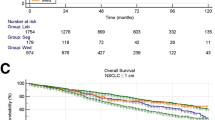Abstract
Objectives
The aim of this study is to evaluate the surgical results of clinical N1 disease and to clarify the high-risk clinical N1 subgroup.
Methods
Between 1990 and 2012, 137 patients who were clinically diagnosed as having N1 disease were enrolled. Their medical records were reviewed to assess clinical characteristics, radiologic findings, pathologic results, postoperative outcomes, recurrence patterns, and survival. Logistic regression analysis was used to identify independent predictive factors for pathologic N2 upstaging. To determine which factors were significantly associated with survival, a multivariate analysis using a Cox proportional hazards model was performed.
Results
More cases were pathological N2 in adenocarcinoma than squamous cell carcinoma (p = 0.039). The overall survival rates at 5 years were 54.9%, 36.7% in group upper lobe, middle and lower lobe, respectively (p = 0.013). Logistic regression analyses revealed that #10 positive (p = 0.002, HR 4.625) and adenocarcinoma (p = 0.029, HR 1.544) were significant predictor of pathologic N2 disease. Multivariate analyses revealed that pathologic N2 (p = 0.007, HR 4.186), middle and lower lobe (p = 0.009, HR 2.045) and presence of #10 (p = 0.024, HR 1.871) were independent prognostic factors. Patients with upper lobe and absence of #10 showed a significantly higher 5-year survival rate than patients with middle and lower lobe and presence of #10 (62.1 vs 25.9%: p < 0.0001).
Conclusions
Among patients with cN1, pathological N2 disease, tumor in middle and lower lobe and clinical #10 lymph node positive were high-risk subgroup. Further analyses using larger numbers of patients with N1 disease from multiple centers are necessary.



Similar content being viewed by others
References
Watanabe S, Asamura H, Suzuki K, Tsuchiya R. Problems in diagnosis and surgical management of clinical N1 non-small cell lung cancer. Ann Thorac Surg. 2005;79:1682–6.
Mountain CF. Revisions in the international system for staging lung cancer. Chest. 1997;111:1710–7.
Rusch VW, Crowley J, Giroux DJ, Goldstraw P, Im JG, Tsuboi M, For the International Staging Committee, Cancer Research, and Biostatistics, Observers to the Committee, Participating Institutions, et al. The IASLC lung cancer staging project: proposals for the revision of the TNM classification for the lung cancer. J Thorac Oncol. 2007;2:603–12.
Shin S, Kim HK, Choi YS, Kim K, Kim J, Shim YM. Prognosis of unexpected and expected pathologic N1 non- small cell lung cancer. Ann Thorac Surg. 2013;96(3):969–75.
Detterbeck FC, Jantz MA, Wallace M, Vansteenkiste J, Silvestri GA. Invasive mediastinal staging of lung cancer: ACCP evidence-based clinical practice guidelines (2nd edition). Chest. 2007;132:202S–20S.
Choi YS, Shim YM, Kim J, Kim K. Mediastinoscopy in patients with clinical stage I non-small cell lung cancer. Ann Thorac Surg. 2003;75:364–6.
De Leyn P, Dooms C, Kuzdzal J, Lardinois D, Passlick B, Weder W, et al. Preoperative mediastinal lymph node staging for non-small cell lung cancer: 2014 update of the 2007 ESTS guidelines. Transl Lung Cancer Res. 2014;3(4):225–33.
Ernst A, Eberhardt R, Krasnik M, Herth FJ. Efficacy of endobronchial ultrasound-guided transbronchial needle aspiration of hilar lymph nodes for diagnosing and staging cancer. J Thorac Oncol. 2009;4:947–50.
Decaluwe H, Dooms C, De Leyn P, Thomas P, Rami-Porta R. Adding an invasive procedure will not necessarily change treatment or outcome of NSCLC patients with preoperative clinical N1 disease. Eur Respir J. 2018;51(4):1800410. https://doi.org/10.1183/13993003.00410-2018.
Libshitz HI, McKenna RJ Jr. Mediastinal lymph node size in lung cancer. AJR. 1984;143:715–8.
Gross BH, Glazer GM, Orringer MB, Spizarny DL, Flint A. Bronchogenic carcinoma metastasis to normal-sized lymph nodes: frequency and significance. Radiology. 1988;166:71–4.
Hishida T, Yoshida J, Nishimura M, Nishiwaki Y, Nagai K. Problems in the current diagnostic standards of clinical N1 non-small cell lung cancer. Thorax. 2008;63:526–31.
Miyoshi K, Mimura T, Iwanaga K, Adachi S, Tsubota N, Okada M. Surgical treatment of clinical N1 non-small cell lung cancer: ongoing controversy over diagnosis and prognosis. Surg Today. 2010;40:428–32.
Fukui T, Kato K, Okasaka T, Kawaguchi K, Fukumoto K, Yokoi K, et al. Predictors for hilar/intrapulmonary lymph node metastasis in discrete type of clinical N1 non-small cell lung cancer. Gen Thorac Cardiovasc Surg. 2017;65:640–5.
van Velzen E, Snijder RJ, Brutel de la Riviere A, Elbers HR, van den Bosch JM. Lymph node type as a prognostic factor for survival in T2 N1 M0 non-small cell lung carcinoma. Ann Thorac Surg. 1997;63:1436–40.
Tanaka F, Yanagihara K, Otake Y, Yamada T, Shoji T, Wada H, et al. Prognostic factors in patients with resected pathologic T1–2N1M0 non-small cell lung cancer. Eur J Cardiothorac Surg. 2001;19:555–61.
Riquet M, Manach D, Le Pimpec-Barthes F, Dujon A, Chehab A. Prognostic significance of surgical-pathologic N1 disease in non-small cell carcinoma of the lung. Ann Thorac Surg. 1999;67:1572–6.
Gilligan D, Nicolson M, Smith I, Groen H, Dalesio O, Stephens R, et al. Preoperative chemotherapy in patients with resectable non-small cell lung cancer: results of the MRC LU22/NVALT 2/EORTC 08012 multicentre randomized trial and update of systematic review. Lancet. 2007;369:1929–37.
NSCLC Meta-analysis Collaborative Group. Preoperative chemotherapy for non-small cell lung cancer: a systematic review and meta-analysis of individual participant data. Lancet. 2014;383:1561–71.
Author information
Authors and Affiliations
Corresponding author
Ethics declarations
Conflict of interest
The authors declare no competing financial interests associated with this study.
Additional information
Publisher's Note
Springer Nature remains neutral with regard to jurisdictional claims in published maps and institutional affiliations.
Rights and permissions
About this article
Cite this article
Tamura, M., Matsumoto, I., Tanaka, Y. et al. Prognostic factor and treatment strategy for clinical N1 non-small cell lung cancer. Gen Thorac Cardiovasc Surg 68, 261–265 (2020). https://doi.org/10.1007/s11748-019-01205-4
Received:
Accepted:
Published:
Issue Date:
DOI: https://doi.org/10.1007/s11748-019-01205-4




